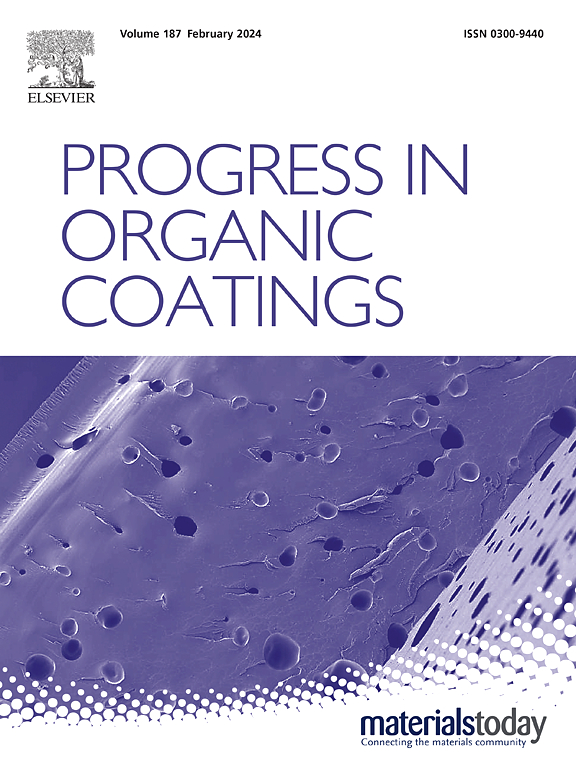Multifunctional Epoxy/PVDF smart coatings using ZIF-8 nanosensor for corrosion protection of mild steel: A study on synthesis and performance
IF 6.5
2区 材料科学
Q1 CHEMISTRY, APPLIED
引用次数: 0
Abstract
A smart multi-functional superhydrophobic coating with self-healing and self-reporting properties was fabricated using benzotriazole (BTA) loaded ZIF-8 (ZBT) particles and phenanthroline (Phen) modified ZIF-8 (ZPH) particles. The structure, functional group and chemical state of particles were analysed using XRD, FTIR and XPS, respectively. The morphology of the prepared particles was studied using FESEM and TEM, respectively. The pH responsive BTA release behavior of ZBT and ZPH as an effective sensor for the detection of Fe2+ ions was confirmed from UV-VIS studies. The Epoxy/Polyvinylidene fluoride (EPV) coating shows hydrophobic nature and EPV/ZIF-8 and EPV/ZBT/ZPH coatings shows superhydrophobic nature. The EIS results show that EPV/ZBT/ZPH coating has highest coating resistance (Rc) and charge transfer resistance (Rct) of 12.48 kΩ.cm2 and 32.18 kΩ.cm2 after 192 h of immersion in 3.5 wt% NaCl solution respectively. The ZBT particles inhibit corrosion by forming a dense layer and ZPH particle forms red colored complex with Fe2+ ions, hence suitable for the detection of corrosion. The cathodic delamination rate of EPV/ZIF-8 and EPV/ZBT/ZPH coatings was determined using SKP. The results elucidated that the presence of ZBT and ZPH particles increases the delamination resistance of the polymer coating.

求助全文
约1分钟内获得全文
求助全文
来源期刊

Progress in Organic Coatings
工程技术-材料科学:膜
CiteScore
11.40
自引率
15.20%
发文量
577
审稿时长
48 days
期刊介绍:
The aim of this international journal is to analyse and publicise the progress and current state of knowledge in the field of organic coatings and related materials. The Editors and the Editorial Board members will solicit both review and research papers from academic and industrial scientists who are actively engaged in research and development or, in the case of review papers, have extensive experience in the subject to be reviewed. Unsolicited manuscripts will be accepted if they meet the journal''s requirements. The journal publishes papers dealing with such subjects as:
• Chemical, physical and technological properties of organic coatings and related materials
• Problems and methods of preparation, manufacture and application of these materials
• Performance, testing and analysis.
 求助内容:
求助内容: 应助结果提醒方式:
应助结果提醒方式:


